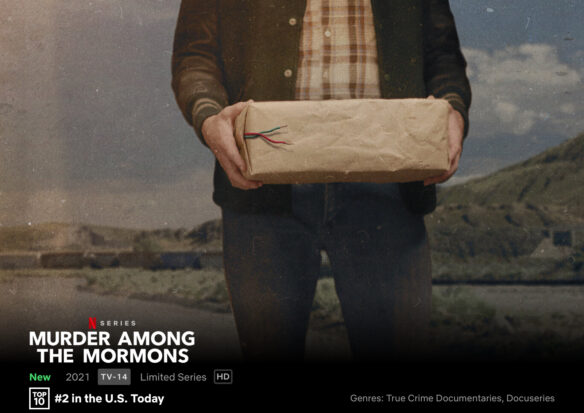
The Netflix documentary about the 1985 bombings in Salt Lake City is being widely promoted and watched.
The documentary is broken into three parts, initially immersing the viewer in the confusion that reigned in the 1980s regarding Mormon history, fomented in part by documents that suggested the Church’s narrative was hagiographic and, frankly, false.
[The idea that an angel appeared to Joseph Smith strains the credulity of the average non-Member. Cut in excerpts from Church videos circa 1980 and toss in the so-called Salamander Letter, and it’s understandable why many watching the first episode could come away with a less-than positive view of the Church of Jesus Christ of Latter-day Saints.]
The bombings, of course, were the work by Mark Hofmann, a man who was eventually revealed to be a forger of many documents, including the Salamander Letter. His forgeries were so good that even the FBI declared them authentic, and this after he had become a suspect for the bombing deaths of Steve Christensen and Kathy Sheets.
Having watched and re-watched the series, I have recommendations regarding how you might wish to experience the documentary.
Episode 1 depicts the milieu of the early 1980s, where the historical openness of the 1970s and “new” documentary evidence was creating massive shifts in understanding regarding the history of the Church of Jesus Christ of Latter-day Saints. This episode culminates in the bombing deaths of Christensen, Sheets, and the bombing damage inflicted on Hofmann himself. I recommend you watch this last.
Episode 2 depicts the investigation that tried to identify the bomber, as many, including the FBI, insisted that Hofmann was selling authentic documents. Eventually, minute details that had escaped even the FBI led to a break in the case. The $2 check Mark Hofmann had written to complete purchase of an engraved plate was another key, found through a single errant receipt found at Hofmann’s home. In other words, he almost got away with it.
Episode 3 takes us through Hofmann’s taped confessions regarding his development into a forger and bomber, which support a narrative of how Hofmann, from childhood, honed his skills at deception and forgery. He was thrilled with his ability to produce convincing fakes, feeling that a thing that was declared true by authorities became, in fact, true. Once convicted to life in prison (rather than the mere 5 years he thought possible), Hofmann tried to get his fellow inmates to kill members of the parole board that denied him release as well as the forensic document expert that detected his fraud. I recommend you watch this first.
As someone aware of the larger damage (which still continues) inflicted by Hofmann’s forgeries, I have seen how numerous historians working in that era formed their theses regarding the history of the Church to fit the Salamander Letter and it’s implication that Joseph Smith was a boy steeped in folk magic and fraud. Even after Hofmann’s documents were proven to be forgeries and precisely excised from books in progress (e.g., Michael Quinn’s Early Mormonism and the Magic Worldview) or subsequent editions of published works (e.g., the biography of Emma Smith, Mormon Enigma), the core framework suggesting Joseph Smith was a magic-influenced fraud remained.
Hofmann’s forgeries have also made it challenging for many to accept well-founded shifts to historical paradigms, as many have decided it is risky to trust new views regarding the past. Many in the historical community, therefore, will ignore or distrust solid evidence, such as DNA, or conclusions based on documents the Church archives have held from the 1840s, long before Hofmann’s forgeries.